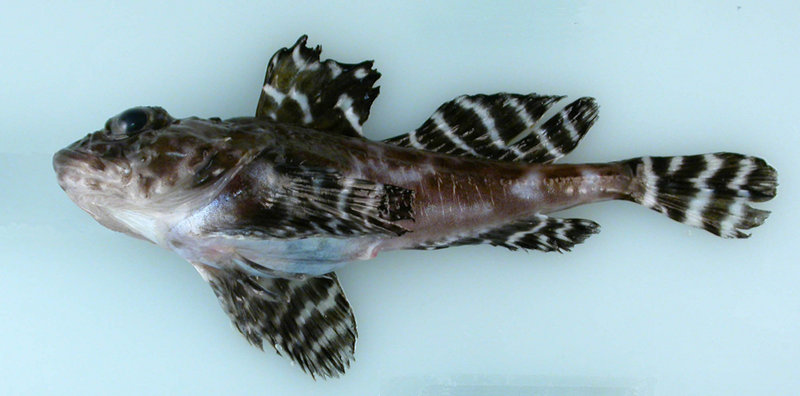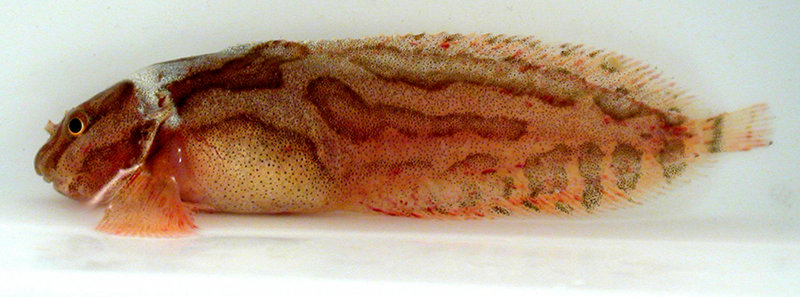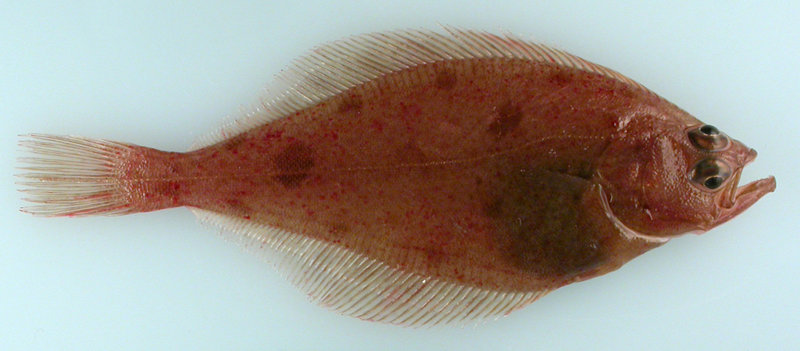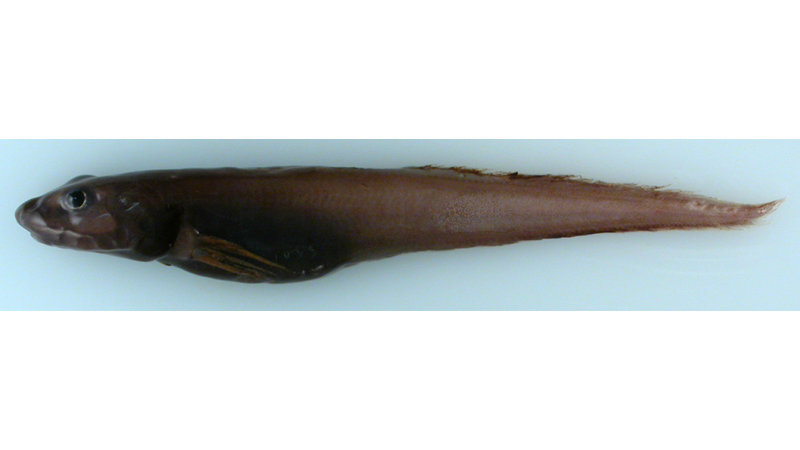
By Catherine W. Mecklenburg, Research Associate - California Academy of Sciences

Atlantic hookear sculpin (Artediellus atlanticus), unknown in the seas off eastern Siberia and western North America until found in the Chukchi Borderland, RUSALCA 2009. Image courtesy of C.W. Mecklenburg, NOAA/RUSALCA. Download larger version (jpg, 525 KB).
My team focuses on the identification and distribution of fishes that live on or near the bottom, the so-called benthic and demersal fishes. We use a bottom trawl net called an “otter trawl” to collect samples. Our mission on the Russian-American Long-term Census of the Arctic (RUSALCA) project has been to generate and disseminate essential information on the poorly studied fish fauna of the Pacific-Arctic region to a wide community of users, including the fish teams in the program focusing on other aspects such as life histories and ecology. We enable current and future monitoring of biodiversity and detection of change by providing basic knowledge on identification of species and accurate assessments of species distributions.

Kelp snailfish (Liparis tunicatus), an abundant species on Arctic continental shelves, collected by RUSALCA in 2004. Image courtesy of C.W. Mecklenburg, NOAA/RUSALCA. Download larger version (jpg, 1.5 MB).

Bering flounder (Hippoglossoides robustus), the first record from the East Siberian Sea, RUSALCA 2009. Image courtesy of C.W. Mecklenburg, NOAA/RUSALCA. Download larger version (jpg, 708 KB).
When the RUSALCA program started, few fishery or ichthyological research investigations had been carried out in this region of dramatic climate change, and the composition of the fish fauna in the region was largely unknown. This was particularly true for the Russian waters of the study area.
Historical collections archived in museums and new collections obtained by participation in the RUSALCA interdisciplinary cruises and other scientific expeditions are our main sources of data. We use standard morphological methods to distinguish among species, supplemented by tissue sampling in the field for DNA analysis. This research has helped solve longstanding problems in identification of Arctic species. Prior to this work, only highly technical, sometimes controversial, works were available to help identify the Pacific-Arctic fishes. Without clear descriptive material and assessments of current distribution, it will not be possible to monitor fishery resources. We are in the midst of preparing an informational atlas and identification guide to the Pacific-Arctic fishes which will enable fish specialists, as well as non-experts, to more accurately identify fish obtained by future monitoring efforts.

Adolf’s eelpout (Lycodes adolfi), unknown in the western Arctic until found in the Chukchi Borderland, RUSALCA 2009. Image courtesy of C.W. Mecklenburg, NOAA/RUSALCA. Download larger version (jpg, 370 KB).
The RUSALCA cruise in 2004 provided records from the Chukchi Sea of several continental shelf species that had rarely been reported for the region, such as great sculpin (Myoxocephalus polyacanthocephalus), gelatinous snailfish (Liparis fabricii), and tubenose poacher (Pallasina barbata).
In 2009, the retreat of the sea ice allowed us to reach deeper waters of the continental slope north of 76°N, where we discovered several species new or rare for the region, including the first records of Adolf’s eelpout (Lycodes adolfi) from the western Arctic, previously known only adjacent to the Atlantic; the first records of marbled eelpout (L. raridens), daubed shanny (Leptoclinus maculatus), and Bering flounder Hippoglossoides robustus from the East Siberian Sea; the first records of Atlantic hookear sculpin (Artediellus atlanticus), bigeye sculpin (Triglops nybelini), polar sculpin (Cottunculus microps), and longear eelpout (Lycodes seminudus) on the Chukchi slope; and others.
A question that always arises is whether these discoveries reflect new movements of fishes into the region (from the Atlantic or the Pacific depending on the species involved), possibly in response to climate change, or if they are simply the result of sampling in previously undersampled areas. Whatever the case may be, the RUSALCA program has enabled a baseline of information to be established.
In 2012, we hope to reach even more unsampled waters to make new discoveries. We also will focus on filling gaps in the current draft of the identification guide by continuing to photograph fresh and living specimens, to extract tissues for DNA barcoding, and to preserve and archive specimens for permanent museum collections to serve as documentation of the catch and provide specimens for taxonomic research.
On board with me in 2012 will be Arve Lynghammer, Ph.D. student at the University of Tromsø, Norway. Also on board, collaborating but also with their own fish teams, will be Elena Voronina from the Zoological Institute at St. Petersburg, Russia (ichthyology) and Brenda Holladay (fisheries ecology) and J. Andres Lopez (ichthyology) of the University of Alaska Fairbanks.